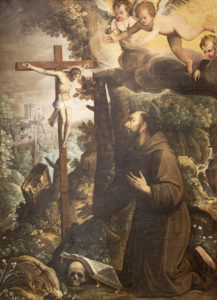Saint Francis of Assisi
 Francis (baptized as Giovanni) was born in 1182, probably on 24 June, by Pietro di Bernardone and Giovanna “Pica”, both from Assisi, committed to fabrics trade.
Francis (baptized as Giovanni) was born in 1182, probably on 24 June, by Pietro di Bernardone and Giovanna “Pica”, both from Assisi, committed to fabrics trade.
The young Francis acquired the ambitions of the merchants to develop social emancipation. Since he belonged to a wealthy family, he played a leading part in his peers’ parties.
Hopefully achieving military glory and more wealth, in 1202 he took part as a knight in the battle against Perugia. However Assisi was defeated and Francis had being thrown in jail for a long year. Disillusion was enormous! To starvation was added the perugian jails’ cold and his health had been seriously affected.
Ransomed by his father, Francis came back home, deeply humiliated in front of his fellows citizen. All the young dreams and the earthly projects had fallen apart.
But pretty soon long-standing ambition of glory and richness appeared again.
The perfect opportunity happened in the spring of 1205. In Spoleto were recruited knights for new military ventures. Francis rushed up to realize the failed aspirations. But everything worked out with a new coherent disillusion. What should he do? The young knight was lost.
But an invisible and patient director worked behind the scenes, it was Lord, capable of so many surprises. He came into young Francis’ life, searching for light, letting him glimpse new and captivating projects.
In the autumn 1205 the experience with the poor people in Rome, the leper’s hug at Rivotorto, the divine inspiration in front of the San Damiano Cross were all psychological and spiritual milestones for a radical change.
Francis’ family failed to understand his behavior. The conflict was unsolvable because the youth had to choose between earthly father and heavenly Father. By the end of March 1206, in front of the bishop Guido I, he gave away all the goods and projects of his family.
He moved away from Assisi and he retired to Gubbio, where he helped lepers (1206-1207). He went back to Assisi and restored three small churches (1207-1208).
The conversion itinerary, pained and determined, ended in spring 1208, on 16 April, when the light of the Gospel clearly revealed God’s plan on him and his followers’ life, and their mission in the church and the society.
Francis and his fellows were inspired by the apostolic community, that one of Jesus with the apostles. The poor and the lepers were their favorites. Every creatures bearers of perfections like their Creator, were brothers and sisters in the same Father.
In the early May 1209 Pope Innocent III approved the draft of sequelae and apostolate that Francis had written «with a few and simple words» by drawing directly to Gospel’s word. Once authorised to preach peace and penitence, the “Penitent of Assisi” left «in order to evangelize the world» (The three C., 53: FF 1462).
The strong testimony of their lives and the itinerant preaching attracted many devoted, willing to improve their Christian conduct. It came to life the «Franciscan Penitent Movement», which encouraged the religious awakening of people and became the matrix of the three Franciscan Orders: Minor friars (Conventuals, Observants, Capuchins), Third order for men and women, the Clare nuns for consecrated women (St. Clare of Assisi, 1195-1253).
The Franciscan Third Order (TOF) developed into two parallel directions: the Third Order Secular (TOS), since 1978 also called Secular Franciscan Order (OFS); the Third Order Regular (TOR), for friars and sisters (each one with a own acronym).
In 1219 Francis went to Holy land and met the Sultan of Egypt, exhorting him to conversion. In May 1220 Francis came back hurriedly to Italy, where he acknowledged the deep change of mentality and the strong divergences among friars. In the general chapter, on 29 September, Francis left the leadership of the Order. He didn’t fell up to the situation, anymore! He remained leader emeritus, symbol of the founding charisma, now tightened by the tangle of institution. He continued his itinerary of evangelization with faith and humility.
On August 1224 Francis retired on the mountain of La Verna during the Lent in honor of Saint Michael the Archangel, living in pray, in fast and contemplation. Here, probably on 14 September, he received the crucified Christ’s stigmata, “nails in high relief”, as S. Bonaventura wrote (LM 13,3: FF 1226). In Assisi, in 1225, he dictated the Canticle of the Creatures.
In the night of 3 October 1226 Francis died at la Porziuncola, exhausted by illnesses and consumed with love. He was 44 years and 3 months old; 20 years and 6 months had already passed from his conversion (at the end of March 1206). Sister Corporal Death lead him to glory. «He had fill the earth with the the Christian message», wrote the biographer (1Cel 97: 488).
He was canonized in Assisi (Church of St. George) by Gregory IX on 16 July 1228. On the following day the Pope laid the first stone for the mighty cathedral.
St. Francis of Assisi looks like a man privileged by God’s mercy and at the same time strongly rooted in existential reality. His evangelic testimony has been eternally present and it is universally admired. His charismatic figure remains message and project. There is such an air of spring around the Poor Little Man of Assisi, the new man called by the Lord to point out the people the path of Christ. With him and the numerous followers of the Franciscan Family, the Evangelic message becomes a living and innovator power in the society, so much in need of peace and love.
